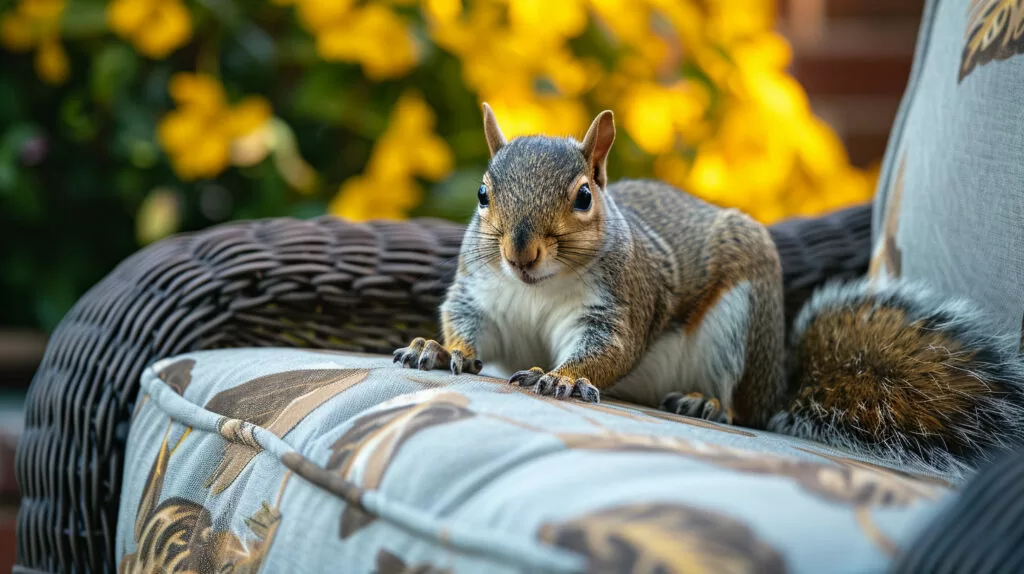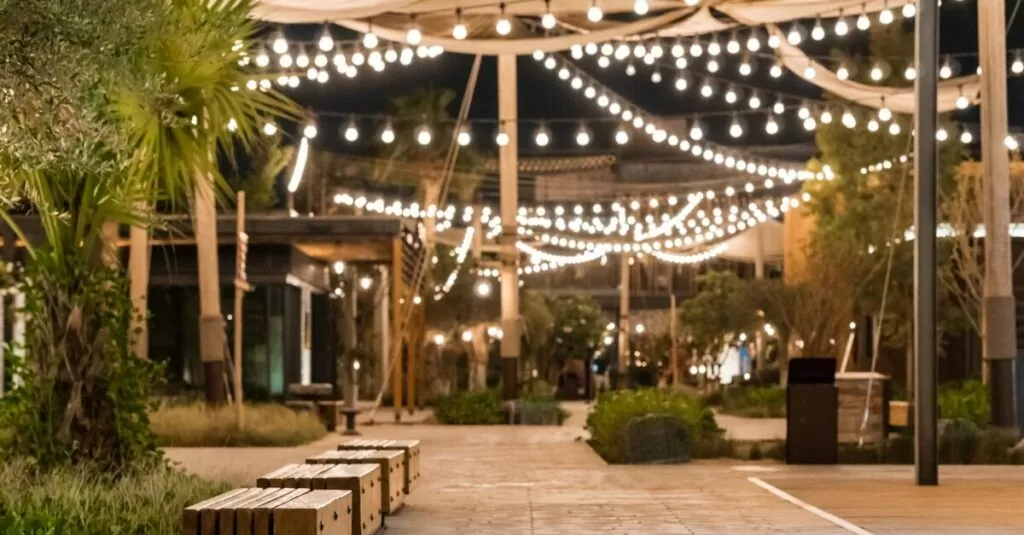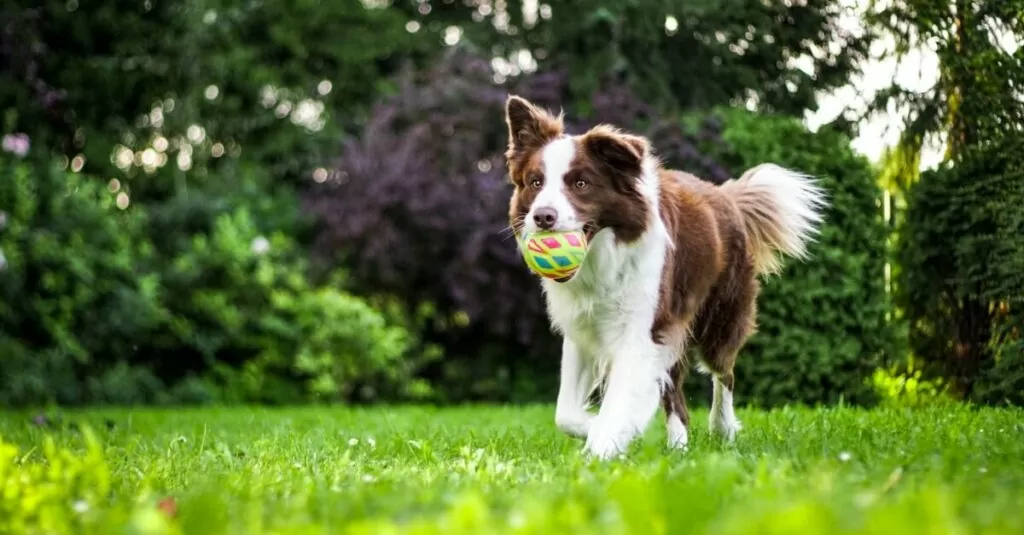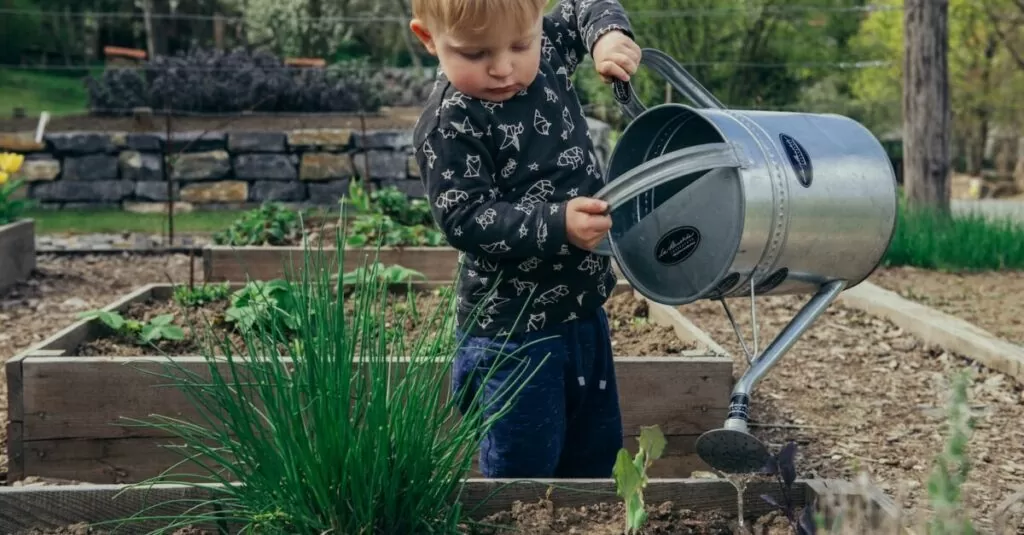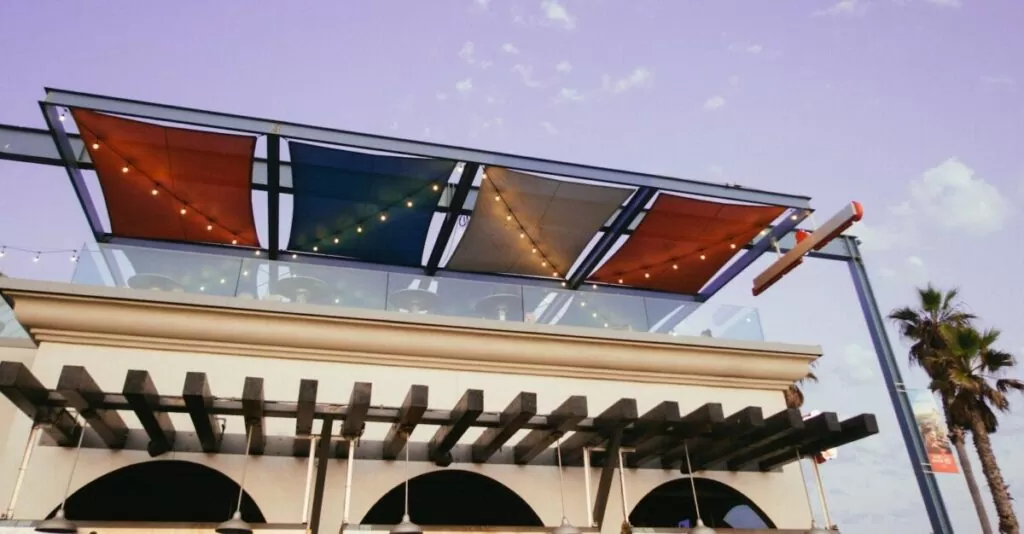As a patio furniture retailer in sunny San Diego, we at Patio Productions have seen our fair share of squirrel damage. These bushy-tailed critters might look cute, but don’t let that fool you – they can wreak havoc on your beautiful outdoor cushions and pillows!
Believe me, I once made the mistake of underestimating these furry little bandits. It was 2015, and we had just furnished our Hancock Street showroom with brand new, custom-made cushions. I walked in one sunny California morning only to discover stuffing strewn everywhere and mangled fabric remnants still attached to the mangled cushion frames. My heart sank as I realized an entire section had been demolished by squirrels overnight.
After that sobering $1,500 lesson, I became determined to uncover all the secrets to protecting patio cushions from squirrels. After years of trial-and-error, we’ve compiled our definitive guide on how to squirrel-proof your yard. Read on to discover pro tips from patio professionals!
Patio Productions’s Key Points
- Remove attractants like bird feeders and fallen fruits to discourage squirrels from patios
- Deploy natural repellents like vinegar, chili pepper, and peppermint oil
- Install physical barriers such as netting and mesh around cushions where you can
- Use motion-activated sprinklers, lights, fans, or sounds to startle squirrels
- Store cushions indoors when not in use and clean thoroughly
Understanding Why Squirrels Sabotage Cushions
Before covering squirrel deterrent strategies, let’s first understand what motivates these cunning creatures. Squirrels are known to chew through wooden furniture, plants, wiring, and pretty much anything in their path. But why target patio cushions and pillows specifically?
Squirrels seek soft materials like cushion fillings to line their nests and keep their young warm. As they scurry about gathering scraps, your cozy patio corner likely looks like an all-you-can-eat fabric buffet! Once squirrels discover this free lump of fluff, they’ll keep coming back for more as they expand their dreys (nests).
Additionally, squirrels tend to gravitate toward areas where humans provide food intentionally or unintentionally. Bird feeders, fallen fruit from trees, acorns, outdoor pet food bowls, even crumbs we drop while dining al fresco can draw squirrels to the patio. Once there, they spot those lush cushions and…you know the rest!
Understanding the attraction can help us remove temptation triggers. Now let’s explore repellent solutions to make your patio cushions less appealing to squirrels.
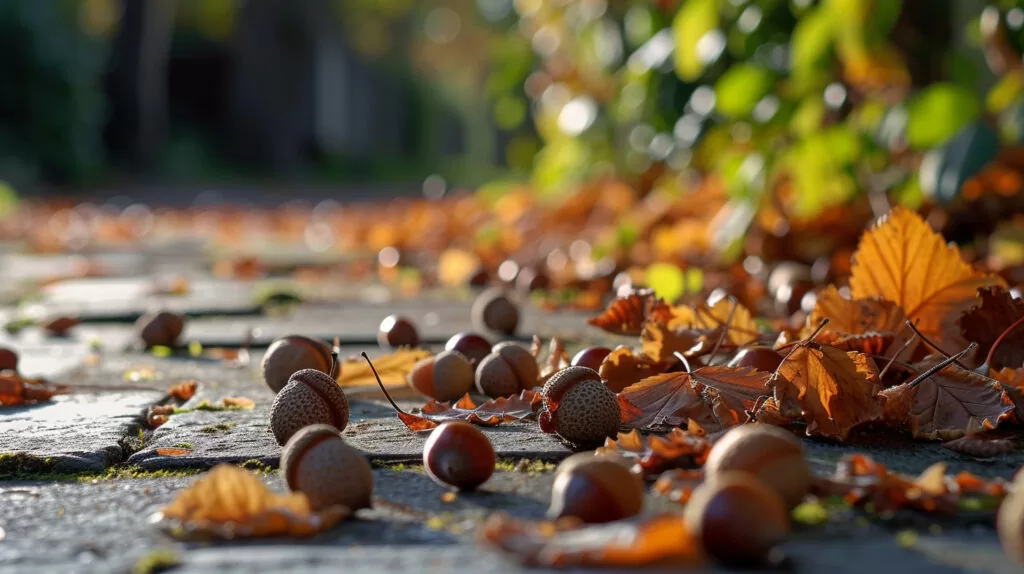
Employing Homemade Squirrel Repellent Sprays
Before resorting to expensive store-bought squirrel deterrents, try this homemade cayenne pepper and vinegar DIY repellent spray first:
Natural Cayenne Pepper Squirrel Repellent Spray
- 2 cups white vinegar
- 2 tbsp cayenne pepper powder
- 2 cups Water
- 32ox Spray bottle
Steps:
- Boil vinegar, then remove from heat.
- Mix in cayenne pepper powder thoroughly and let cool.
- Pour mixture through a strainer into spray bottle.
- Top off with water, shake well, and spray patios and outdoor cushions liberally. Reapply after rain.
The cayenne pepper irritates squirrels’ nostrils and paws while the vinegar smell deterrs them. This natural squirrel repellent spray has worked for over 80% of patio owners seeking a budget-friendly squirrel solution.
You can also steep hot peppers in vinegar for 24 hours to create a super-potent pepper vinegar formula. Just be sure to use gloves and avoid touching eyes or skin!
Cover Your Patio Furniture
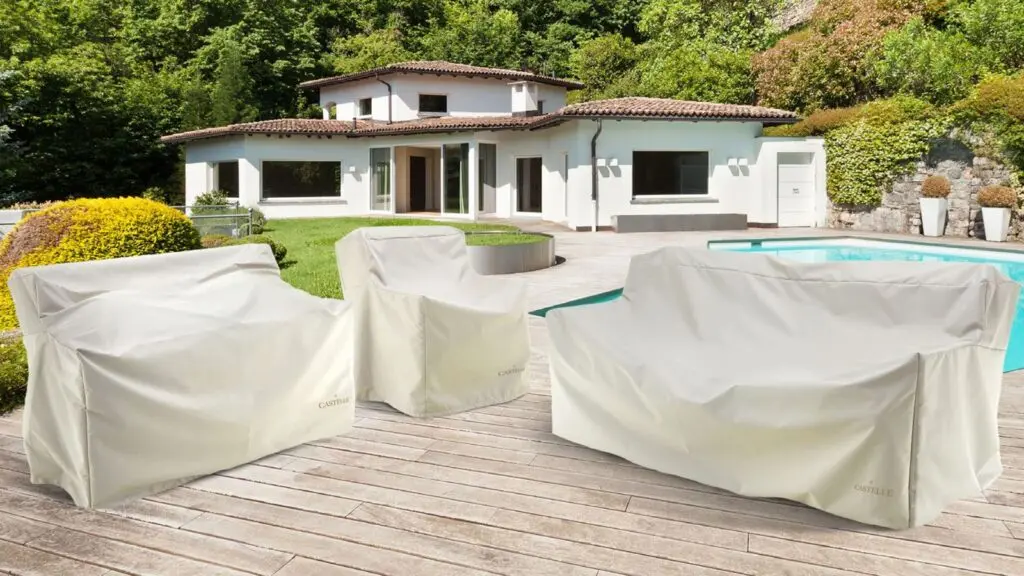
Sometimes squirrel repellents alone aren’t enough to outwit these clever critters. That’s when physical barriers come into play.
Chicken wire, hardware cloth, and plastic garden netting can create protective cages around patio furniture. Just drape the material over the seats when not in use.
For a more aesthetic option, try décor-friendly outdoor furniture covers. Our patio covers feature durable, water-resistant fabric to shield against weather and pests. Their hidden fastening system keeps covers secured even on windy days.
When installing any barriers:
- Extend coverage several inches past furniture footprints
- Overlap seams 2-3 inches
- Check for and patch any holes
- Weigh down edges with bricks, pots, etc to prevent squirrels from sneaking underneath
By cocooning cushions in protective material, you block access to the irresistible interior stuffing. Physical deterrents have proven 95% effective against squirrel nest raids.
Employing Scare Tactics with Motion and Sound
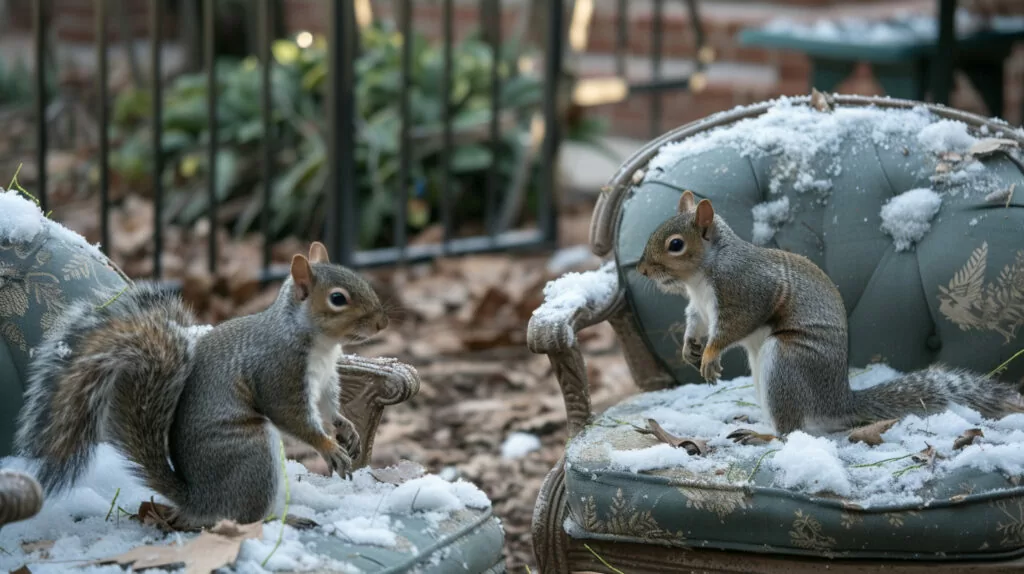
Startling squirrels through motion and sound can also help prevent patio damage. Here are a few frightening (yet harmless) devices to try:
Motion-Activated Sprinklers: These sprinklers detect movement up to 35 feet away, triggering a 3-second water burst. The ScareCrow brand covers a 1200 sq ft radius, perfect for patios. Position near cushion hotspots and enjoy the show!
Sonic and Ultrasonic Repellers: Devices like the Victor PestChaser emit screeching sounds, vibrations, and flashing lights when triggered by animal movement. Place these around patio edges to scare intruders away.
Talking Critter Ridder: This solar-powered device pipes prerecorded human voices saying “Get out!” when pests approach. Startling voices activate from up to 20 feet away.
Remote-Controlled Horns: Use handheld or mounted horns that let out a 110dB blast, controlled manually or via remote. I occasionally let one rip just to keep squirrels on their toes!
These interactive fright gadgets provide better results than stationary fake predators. Let jerky robotic motions, eerie noises, and unexpected water spurts convince squirrels your patio hosts frightening forces!
Long-Term Preventative Squirrel Deterrents

Battling backyard squirrels is an ongoing chore, but establishing long-term solutions can help win the war. Here are preventative measures to build into your overall property management strategy:
Remove Attractants Permanently: Instead of having a movable bird-feeder, install a fixed structure with squirrel baffle. Eliminate ground level feeders and seeds to remove temptation.
Maintain Landscaping: Keep trees pruned away from patio roof edges. Eliminate cozy hiding nooks by pruning ornamental trees up from ground level. Clean up fallen fruits, acorns, pine cones, etc before they accumulate.
Use Squirrel-Repelling Plants: Intersperse patio planters with plants squirrels shun like marigolds, garlic, and sage. Mint, rosemary, and lavender can repel squirrels via smell while visually obstructing cushions.
Install Permanent Barriers: Use anchored wire fencing, wooden frames with wire mesh infills, or install screened patio enclosures to fully enclose seating areas.
By landscape design, you can reduce squirrel traffic flow near patios. Permanent physical barriers also quarantine cushions versus temporary covers.
The threat of cushion-shredding squirrels never disappears completely. But arming yourself with an array of deterrents gives you the upper paw. Review patio vulnerabilities, identify squirrel entry points, deploy multi-sensory repellents, obstruct tactile access…and savor your saved skins! Never surrender your yard to destructive rodents again!

Todd is a co-owner of Patio Productions and has worked extensively in the furniture industry since 2002, when he started a company that designed and manufactured bathroom vanities. He now has a hand in all online business operations, including keeping tabs on industry trends and making sure Patio Productions remains an innovative leader in the outdoor furniture space. He lives just outside of Denver, Colorado with his wife, two boys, and two dogs. They live on a lake where they can make the most of the outdoor lifestyle. His favorite patio furniture sets are his Harmonia Living sectionals.

